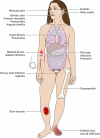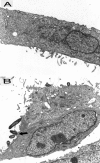Polymicrobial interactions: impact on pathogenesis and human disease
- PMID: 22232376
- PMCID: PMC3255964
- DOI: 10.1128/CMR.00013-11
Polymicrobial interactions: impact on pathogenesis and human disease
Abstract
Microorganisms coexist in a complex milieu of bacteria, fungi, archaea, and viruses on or within the human body, often as multifaceted polymicrobial biofilm communities at mucosal sites and on abiotic surfaces. Only recently have we begun to appreciate the complicated biofilm phenotype during infection; moreover, even less is known about the interactions that occur between microorganisms during polymicrobial growth and their implications in human disease. Therefore, this review focuses on polymicrobial biofilm-mediated infections and examines the contribution of bacterial-bacterial, bacterial-fungal, and bacterial-viral interactions during human infection and potential strategies for protection against such diseases.
Figures














References
-
- Abramson JS, Wheeler JG. 1994. Virus-induced neutrophil dysfunction: role in the pathogenesis of bacterial infections. Pediatr. Infect. Dis. J. 13:643–652 - PubMed
-
- Alberti KG, Zimmet PZ. 1998. Definition, diagnosis and classification of diabetes mellitus and its complications. Part 1: diagnosis and classification of diabetes mellitus provisional report of a WHO consultation. Diabet. Med. 15:539–553 - PubMed
-
- Al-Fattani MA, Douglas LJ. 2006. Biofilm matrix of Candida albicans and Candida tropicalis: chemical composition and role in drug resistance. J. Med. Microbiol. 55:999–1008 - PubMed
Publication types
MeSH terms
Grants and funding
LinkOut - more resources
Full Text Sources
Other Literature Sources
Medical

